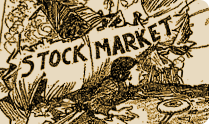The Crash of 1929
An AMERICAN EXPERIENCE Seminar
Thursday, April 7, 2011
7:00 p.m.–8:30 p.m. (EST)

Leader
Edward J. Balleisen
Associate Professor of History
Duke University
National Humanities Center Fellow
About the Seminar
The Great Depression confronts teachers and students of history with some classic challenges of historical analysis. How does one disentangle proximate and deeper causes of this calamitous economic collapse? How did historical protagonists make sense of the course of epochal events that so rapidly transformed their worlds? To what extent should we characterize the onset of the Great Depression as an historical event of a particular type — in this case, a financial panic and ensuring economic downturn — that followed a predictable trajectory in line with the American panics and depressions that had preceded it for over a century? By contrast, in what ways did the Great Crash and its aftermath diverge from earlier experience, or from later developments?
As you watch the American Experience documentary film The Crash of 1929, and as you encounter the related documents collected for this seminar, keep in mind two very different modes of historical interpretation. The first involves the effort to recapture the implications of historical change for particular individuals and groups, as well as the meanings that these historical actors attached to those events. This approach calls for analytical close-ups, whether of individual experience or specific attempts to interpret the significance of the crash.
The second mode considers the American economy and political system as larger wholes, probing for overarching structural dynamics, causes, and consequences. This method often turns to comparison, either with the contemporaneous situation in other societies, or with other periods in American history (nineteenth century panics, the moderation of the business cycle from 1946 through the 1970s, or the more recent economic volatility of the last thirty, and especially ten, years).
Enter Moodle Forum
Assigned Readings
To incorporate seminar texts into your teaching, we offer the National Humanities Center’s Primary Document Application Form.- Emotional Responses to the Crisis (PDF)
- Dow Jones Industrial Average, 1914–1997 (chart)
- Telegram to President Hoover, Oct. 29, 1929
- “Wall Street’s ‘Prosperity Panic’”, Literary Digest, 1929
- “Going Into A Huddle”
- Editorial Cartoons
- WPA Federal Writers Project, “Interview with George Mehales” (excerpt)
- Hard Times: An Oral History of the Great Depression, Studs Terkel, 1970
- Arthur A. Robertson, Chairman, NYSE listed company
- John Hersch, Senior Partner, brokerage firm
- Proximate Cause: The Stock Market (PDF)
- Advertisements/comics
- Chicago Tribune and New York Times articles
- Financial Intermediaries shares of assets, 1929 (chart)
- American Telephone and Telegraph, Report to the Stockholders for 1929
- Structural Causes: The Credit Economy (PDF)
- Advertisements, et al.
- Middletown: A Study in Modern American Culture, Robert and Helen Lynd, 1929 (excerpt)
- Net Private Debt by Sector, 1916–1976 (chart)
- “No One Has a Monopoly on Bad Luck”
- American interest rates, 1914–1997 (chart)
- Rate of Change in Overall American Prices, 1914–1997 (chart)
- Structural Causes: The Faith in Market Technocracy (PDF)
- “This Era of Investment Trusts”, Irving Fisher, 1929
- “Instalment Sales Unaffected in Lull”, New York Times, 1928
- “The New Day,” Herbert Hoover, New York City Campaign Speech, 1928
- The Great Crash in Long-Term Historical Perspective (PDF)
- Major Financial Panics in American History, 1800–1940
- Bank Failures, Inequality, and Regulation in the United States, 1864–2009
Suggested Additional Readings
PDF with links to resourcesPresentation
PowerPoint: 3.4 MBOnline Evaluation
Seminar Recording
Download Recording (You will need to install the WebEx ARF player, available at download, to play back the recording.)
